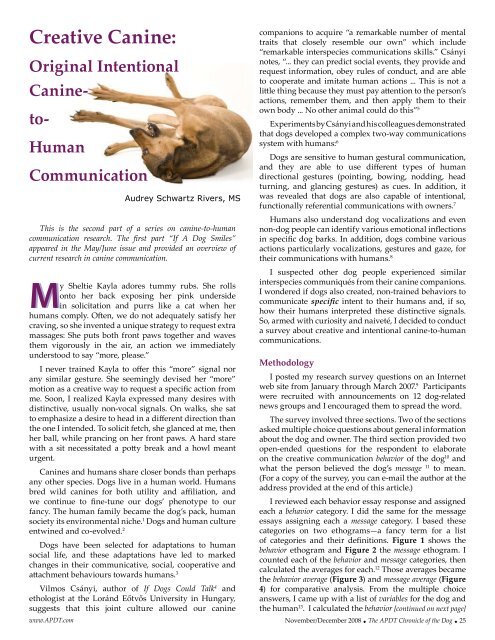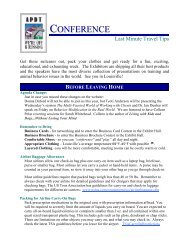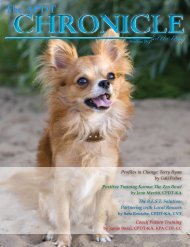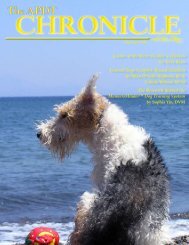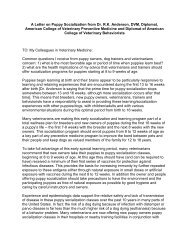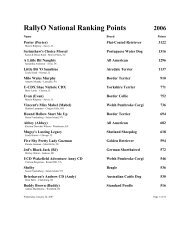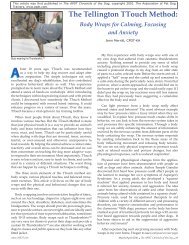of the Dog - Association of Pet Dog Trainers
of the Dog - Association of Pet Dog Trainers
of the Dog - Association of Pet Dog Trainers
You also want an ePaper? Increase the reach of your titles
YUMPU automatically turns print PDFs into web optimized ePapers that Google loves.
Creative Canine:<br />
Original Intentional<br />
Canine-<br />
to-<br />
Human<br />
Communication<br />
This is <strong>the</strong> second part <strong>of</strong> a series on canine-to-human<br />
communication research. The first part “If A <strong>Dog</strong> Smiles”<br />
appeared in <strong>the</strong> May/June issue and provided an overview <strong>of</strong><br />
current research in canine communication.<br />
My<br />
M<br />
Sheltie Kayla adores tummy rubs. She rolls<br />
onto her back exposing her pink underside<br />
in solicitation and purrs like a cat when her<br />
humans comply. Often, we do not adequately satisfy her<br />
craving, so she invented a unique strategy to request extra<br />
massages: She puts both front paws toge<strong>the</strong>r and waves<br />
<strong>the</strong>m vigorously in <strong>the</strong> air, an action we immediately<br />
understood to say “more, please.”<br />
I never trained Kayla to <strong>of</strong>fer this “more” signal nor<br />
any similar gesture. She seemingly devised her “more”<br />
motion as a creative way to request a specific action from<br />
me. Soon, I realized Kayla expressed many desires with<br />
distinctive, usually non-vocal signals. On walks, she sat<br />
to emphasize a desire to head in a different direction than<br />
<strong>the</strong> one I intended. To solicit fetch, she glanced at me, <strong>the</strong>n<br />
her ball, while prancing on her front paws. A hard stare<br />
with a sit necessitated a potty break and a howl meant<br />
urgent.<br />
Canines and humans share closer bonds than perhaps<br />
any o<strong>the</strong>r species. <strong>Dog</strong>s live in a human world. Humans<br />
bred wild canines for both utility and affiliation, and<br />
we continue to fine-tune our dogs’ phenotype to our<br />
fancy. The human family became <strong>the</strong> dog’s pack, human<br />
society its environmental niche. 1 <strong>Dog</strong>s and human culture<br />
entwined and co-evolved. 2<br />
<strong>Dog</strong>s have been selected for adaptations to human<br />
social life, and <strong>the</strong>se adaptations have led to marked<br />
changes in <strong>the</strong>ir communicative, social, cooperative and<br />
attachment behaviours towards humans. 3<br />
Vilmos Csányi, author <strong>of</strong> If <strong>Dog</strong>s Could Talk 4 and<br />
ethologist at <strong>the</strong> Loránd Eőtvős University in Hungary,<br />
suggests that this joint culture allowed our canine<br />
www.APDT.com<br />
Audrey Schwartz Rivers, MS<br />
companions to acquire “a remarkable number <strong>of</strong> mental<br />
traits that closely resemble our own” which include<br />
“remarkable interspecies communications skills.” Csányi<br />
notes, “... <strong>the</strong>y can predict social events, <strong>the</strong>y provide and<br />
request information, obey rules <strong>of</strong> conduct, and are able<br />
to cooperate and imitate human actions ... This is not a<br />
little thing because <strong>the</strong>y must pay attention to <strong>the</strong> person’s<br />
actions, remember <strong>the</strong>m, and <strong>the</strong>n apply <strong>the</strong>m to <strong>the</strong>ir<br />
own body ... No o<strong>the</strong>r animal could do this” 5<br />
Experiments by Csányi and his colleagues demonstrated<br />
that dogs developed a complex two-way communications<br />
system with humans: 6<br />
<strong>Dog</strong>s are sensitive to human gestural communication,<br />
and <strong>the</strong>y are able to use different types <strong>of</strong> human<br />
directional gestures (pointing, bowing, nodding, head<br />
turning, and glancing gestures) as cues. In addition, it<br />
was revealed that dogs are also capable <strong>of</strong> intentional,<br />
functionally referential communications with owners. 7<br />
Humans also understand dog vocalizations and even<br />
non-dog people can identify various emotional inflections<br />
in specific dog barks. In addition, dogs combine various<br />
actions particularly vocalizations, gestures and gaze, for<br />
<strong>the</strong>ir communications with humans. 8<br />
I suspected o<strong>the</strong>r dog people experienced similar<br />
interspecies communiqués from <strong>the</strong>ir canine companions.<br />
I wondered if dogs also created, non-trained behaviors to<br />
communicate specific intent to <strong>the</strong>ir humans and, if so,<br />
how <strong>the</strong>ir humans interpreted <strong>the</strong>se distinctive signals.<br />
So, armed with curiosity and naiveté, I decided to conduct<br />
a survey about creative and intentional canine-to-human<br />
communications.<br />
Methodology<br />
I posted my research survey questions on an Internet<br />
web site from January through March 2007. 9 Participants<br />
were recruited with announcements on 12 dog-related<br />
news groups and I encouraged <strong>the</strong>m to spread <strong>the</strong> word.<br />
The survey involved three sections. Two <strong>of</strong> <strong>the</strong> sections<br />
asked multiple choice questions about general information<br />
about <strong>the</strong> dog and owner. The third section provided two<br />
open-ended questions for <strong>the</strong> respondent to elaborate<br />
on <strong>the</strong> creative communication behavior <strong>of</strong> <strong>the</strong> dog10 and<br />
what <strong>the</strong> person believed <strong>the</strong> dog’s message 11 to mean.<br />
(For a copy <strong>of</strong> <strong>the</strong> survey, you can e-mail <strong>the</strong> author at <strong>the</strong><br />
address provided at <strong>the</strong> end <strong>of</strong> this article.)<br />
I reviewed each behavior essay response and assigned<br />
each a behavior category. I did <strong>the</strong> same for <strong>the</strong> message<br />
essays assigning each a message category. I based <strong>the</strong>se<br />
categories on two ethograms—a fancy term for a list<br />
<strong>of</strong> categories and <strong>the</strong>ir definitions. Figure 1 shows <strong>the</strong><br />
behavior ethogram and Figure 2 <strong>the</strong> message ethogram. I<br />
counted each <strong>of</strong> <strong>the</strong> behavior and message categories, <strong>the</strong>n<br />
calculated <strong>the</strong> averages for each. 12 Those averages became<br />
<strong>the</strong> behavior average (Figure 3) and message average (Figure<br />
4) for comparative analysis. From <strong>the</strong> multiple choice<br />
answers, I came up with a list <strong>of</strong> variables for <strong>the</strong> dog and<br />
<strong>the</strong> human13 . I calculated <strong>the</strong> behavior [continued on next page]<br />
November/December 2008 w The APDT Chronicle <strong>of</strong> <strong>the</strong> <strong>Dog</strong> w 25


